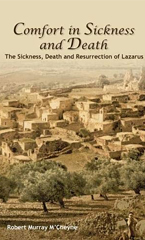The Lord Jesus Christ loves His people, and this is seen throughout the events surrounding the death and raising of Lazarus in John 11. Each of the seven gentle but compelling messages contained in this book focuses on themes calculated to bring consolation to those undergoing the trials associated with sickness, death and bereavement. Unbelief and mistrust are handled faithfully, together with Christ’s revelation of himself as the resurrection and the life, and His tears at the tomb of Lazarus.
Introduction: Bethany – The Tomb of Lazarus
The following description of modern Bethany is extracted from a very interesting volume, published by the Board of Publication, entitled “Narrative of a Mission of Inquiry to the Jews, from the Church of Scotland, in 1839.” The authors of the volume were the Rev A A Bonar and the Rev R M M’Cheyne. It seems to form an appropriate Introduction to this little volume. – [Editor of The Presbyterian Board of Publication.]
Descending and leaving the Jericho road, we came quite suddenly upon Bethany, called by the Arabs Azarieh, from the name of Lazarus. We found this ever-memorable village to be very like what we could have imagined it. It lies almost hidden in a small ravine of Mount Olivet, so much so that from the height it cannot be seen. It is embosomed in fruit trees, especially figs and almonds, olives and pomegranates. The ravine in which it lies is terraced, and the terraces are covered either with fruit trees or waving grain. There are not many houses, perhaps about twenty, inhabited, but there are many marks of ancient ruins. The house of Lazarus was pointed out to us, a substantial building, probably a tower in former days, and selected to bear the name of the House of Lazarus by traditionists, who did not know how else than by his worldly eminence such a man could draw the special regard of the Lord Jesus. They did not know that Christ loveth freely.
The sepulchre called the Tomb of Lazarus attracted more of our attention. We lighted our tapers, and descended twenty-six steps cut in the rock, to a chamber deep in the rock, having several niches for the dead. Whether this be the very tomb where Lazarus lay four days, and which yielded up its dead at the command of Jesus, it is impossible to say. The common objection, that it is too deep, seems entirely groundless, for there is nothing in the narrative to intimate that the tomb was on a level with the ground, and besides, it seems not unlikely that there was another entrance to the tomb further down the slope. A stronger objection is, that the tomb is in the immediate vicinity of the village, or actually in it; but it is possible that the modern village occupies ground a little different from the ancient one. However this may be, there can be no doubt that this is “Bethany, the town of Mary and her sister Martha, nigh unto Jerusalem, about fifteen furlongs off.” (John 11:1, 18).
How pleasing are all the associations that cluster around it! Perhaps there was no scene in the Holy Land which afforded us more unmingled enjoyment: we even fancied that the curse that everywhere rests so visibly upon the land had fallen more lightly here.
In point of situation, nothing could have come up more completely to our previous imagination of the place to which Jesus delighted to retire at evening, from the bustle of the city, and the vexations of the unbelieving multitudes – sometimes traversing the road by which we had come, and perhaps more often coming up the face of the hill by the footpath that passes on the north of Gethsemane. What a peaceful scene! Amidst these trees, or in that grassy field, he may often have been seen in deep communion with the Father. And in sight of this verdant spot it was that he took his last farewell of the disciples, and went upward to resume the deep, unbroken fellowship of “his God, and our God,” uttering blessings even at the moment when he began to be parted from them. (Luke 24:51). And it was here that the two angels stood by them in white apparel, and left us this glorious message, “This same Jesus, which is taken up from you into heaven, shall so come in like manner as ye have seen him go into heaven” (Acts 1:11).
Used with Permission. This book is available at Trinity Book Service

